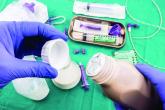News

Which tube placement is best for a patient requiring enteral nutrition?
- Author:
- Bibhusan Basnet, MD
- Cory Gallivan
- Oms III
- Carla Tayes
Publish date: April 2, 2020
Early enteral nutrition is essential in hospitalized patients unable to maintain oral nutrition.
